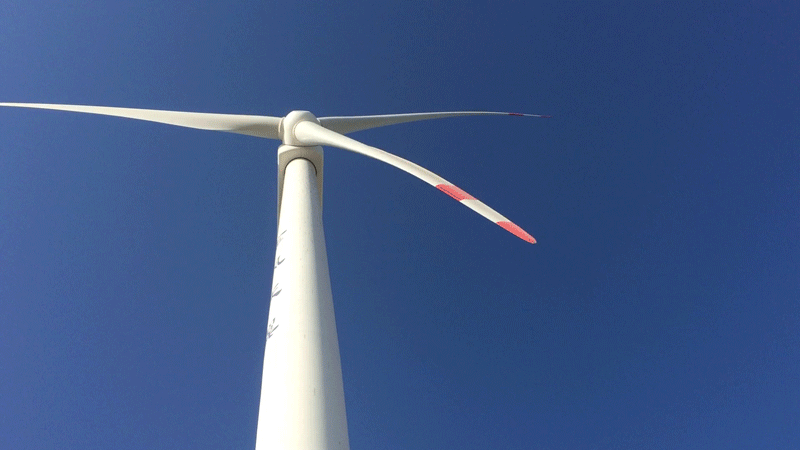China taps faraway frontier for renewable energy
The Dabancheng wind farm is closer to Kabul than Beijing, but China’s government is counting on it to help power the central and eastern parts of the country where the bulk of the population lives, more than a thousand miles away.
The blades of one of hundreds of turbines, each the length of half a football field, rip through the air, thrusting like a jet with each rotation. They’re pushed by 40 mile-per-hour wind gusts, blowing through a narrow valley between snow-capped mountains of the Tian Shan range to the north toward the Tarim Basin in the desert south.

A wind turbine at Dabancheng, China’s first wind farm built in 1989. (Rob Schmitz/Marketplace)
“The history of China’s wind power started here,” shouts Zhu Xinxiang through a heavy gust of wind.
Zhu is a general manager at Goldwind. His company established China’s first wind farm here in 1989, a bygone era when there weren’t any construction cranes to be found in this part of China, so Goldwind had to enlist the help of government officials from Denmark, who donated one to build the farm’s first turbines.
Computer screens inside Goldwind’s wind power station at Dabancheng show the electricity being generated. Goldwind is the world’s second-largest wind turbine manufacturer. (Rob Schmitz/Marketplace)
Nearly three decades later, China’s the world’s second-biggest economy, Goldwind is the world’s second-largest wind turbine maker, and Dabancheng has expanded to hundreds of turbines, generating enough electricity to power 2.5 million homes. But there’s a problem.
“China is a vast land, and here in Xinjiang, we’re very far away from the rest of the country,” Zhu said. “We need transmission to send this electricity thousands of miles away.”
Zhu points to the south, where Goldwind has just built nearly a hundred top-of-the-line turbines. The fierce wind blows through them, too, but their blades aren’t turning. Goldwind is waiting for China’s electrical grid to catch up.
Zhu Xinxiang
The government’s building five ultra-high transmission lines in Xinjiang to send this energy to the places that need it, but it will take time. “A huge transmission line takes three to five years to build, but a wind farm only takes a year to build, said former Goldwind CEO Yu Wuming.
And that’s why, said Goldwind’s Zhu Xinxiang, 40 percent of the electricity generated by Dabancheng in the past year went nowhere. The energy could have powered a million homes, preventing air pollution and reducing China’s carbon footprint, but there weren’t transmission lines in place to carry it all.
The industry calls this curtailment, and it is a big problem in China.
“Here’s a country which has had the biggest build-out of wind power we’ll probably see anywhere,” said Mark Clifford, author of “The Greening of Asia.” “And yet a lot of these turbines are just spinning idly and the power isn’t used, sometimes for political reasons, sometimes for technical reasons. The point is they’re wasting a lot of the investment that they put into wind power.”
According to 2014 data, China has installed twice as many wind turbines as the United States. However, the U.S. produces 18 percent more wind energy than China.
Dabancheng wind turbines
That’s because nearly one out of every five wind turbines in China isn’t spinning. The transmission isn’t in place or China’s national grid is unwilling to take the energy. Apart from wasting clean energy, this has meant China’s wind power industry has lost more than a billion dollars in the first half of this year alone.
“A waste rate of 20 percent isn’t acceptable in any other country,” said Yuan Ying, a senior campaigner for renewable energy at Greenpeace’s office in Beijing, “A reasonable curtailment rate would be 1 or 2 percent. This is a fatal problem.”
Yuan said she’s also worried by recent data that show China’s government is falling back on burning coal.
“The number of coal-fired plants exceeds what was originally planned,” she said. “It’s creating a coal bubble and this excess supply of coal power will make it even harder to develop renewable energy.”
Goldwind’s newest turbines at Dabancheng stand still, amid a sandstorm. The reason they’re not spinning? China hasn’t yet installed enough grid capacity to accommodate their energy. (Rob Schmitz/Marketplace)
But at Dabancheng wind farm in Xinjiang, Goldwind’s Zhu Xinxiang is confident China’s waste of renewable energy will be short-lived. He points beyond his turbines to transmission towers in the distance. “They’ve already built a few lines over there. More of them are on their way,” he said.
In five years, these new lines will carry enough electricity to power nearly 50 million households more than a thousand miles away on the other side of China. When that happens, Zhu hopes all the turbines on this wind farm will be spinning, helping China surpass the United States to produce the most wind energy of any country on the planet.
There’s a lot happening in the world. Through it all, Marketplace is here for you.
You rely on Marketplace to break down the world’s events and tell you how it affects you in a fact-based, approachable way. We rely on your financial support to keep making that possible.
Your donation today powers the independent journalism that you rely on. For just $5/month, you can help sustain Marketplace so we can keep reporting on the things that matter to you.












